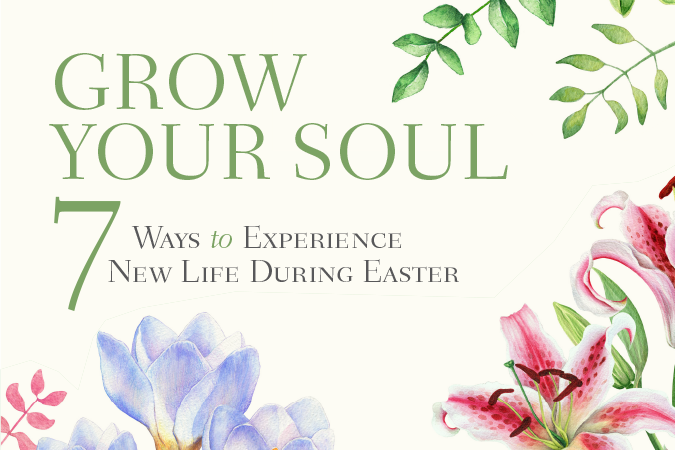Welcome to the next installment of my Easter series, “Grow Your Soul: 7 Ways to Experience New Life During Easter,” drawing from my book, 7 Keys to Spiritual Wellness. Today we look at the notion of seeking beauty.
On Easter Sunday, we expect the weather to be beautiful. We count on it being a sunny, mild day so that we can all put on our Easter best without having to be covered up by layers of clothes to protect against the cold and rain. We imagine green grass, flowers, and blue skies as opposed to the gray skies and brown lawns of winter and early spring. The church is decorated with colorful flowers and banners, and people come dressed in splendid spring colors. Whether the above occurs or not, Jesus is risen! However, we desire our physical world to reflect the beauty of the feast.
We human beings crave beauty. When we think of going on vacation, we immediately begin to imagine ourselves in a place surrounded by beauty, and the most popular vacation spots in the world tend to be filled with glorious beauty. Beauty is one of the three infinite attributes of God, along with truth and goodness. In our Christian tradition, however, most of our emphasis has been and continues to be on the truth and goodness of God. In recent times, some theologians have sought to shift attention to the Divine attribute of beauty as a much-needed balm for our weary souls. The brilliant theologian Hans Urs Von Balthasar wrote the following:
We no longer dare to believe in beauty, and we make of it a mere appearance in order the more easily to dispose of it. Our situation today shows that beauty demands for itself at least as much courage and decision as do truth and goodness, and she will not allow herself to be separated and banned from her two sisters without taking them along with herself in an act of mysterious vengeance. We can be sure that whoever sneers at her name as if she were the ornament of a bourgeois past, whether he admits it or not, can no longer pray and soon will no longer be able to love.
—The Glory of the Lord: A Theological Aesthetics, Vol. 1, Seeing the Form
Our appreciation of beauty is tied to our capacity to pray and to love. As such, we would do well not to relegate our encounters with beauty to a couple of weeks of vacation each year. Instead, we can expand our souls by encountering beauty year-round, in nature or in music, dance, literature, theater, athletics, and so on. Catholic prayer and worship is imbued with beauty; beautiful artwork, music, words, signs, symbols, gestures, and rituals are all a part of the treasury of Catholic spirituality that enables us to encounter Divine beauty.
In a number of reflections on art and beauty, Pope Emeritus Benedict XVI shared some profound thoughts about beauty and spirituality:
- Art and beauty are “something bigger, something that speaks, capable of touching the heart, of communicating a message, of elevating the soul. How many times, then, can artistic expressions be occasions to remind us of God, to help our prayer or the conversion of the heart.”
- Works of art “open the door to the infinite, to a beauty and a truth that goes beyond the ordinary. A work of art can open the eyes of the mind and heart. Perhaps sometimes, before a sculpture, a painting, a few verses of a poem or a song, you have experienced deep within an intimate emotion, a sense of joy, that is to have clearly perceived that in front of you there was not only matter, a piece of marble or bronze, a painted canvas, a series of letters or a combination of sounds, but something bigger, something that speaks, capable of touching the heart, of communicating a message; elevating the soul.”
- “The work of art is the fruit of human creativity, which questions the visible reality, trying to discover its deep meaning and to communicate it through the language of shapes, colors, sounds. [It] is an open door on the infinite [which] opens the eyes of the mind, of the heart. One example of this is when we visit a Gothic cathedral; we are enraptured by the vertical lines that shoot up towards the sky and draw our eyes and our spirits upwards, while at the same time, we feel small, and yet eager for fullness.”
- “How many times have paintings or frescoes, the fruit of the faith of the artist, in their forms, their colors, in their light, encouraged us to direct our thoughts to God and nourish in us the desire to draw from the source of all beauty. What a great artist, Marc Chagall, wrote remains true, that for centuries painters have dipped their paintbrush in that colored alphabet that is the Bible. How many times then can artistic expressions be occasions to remind us of God, to help our prayer or for the conversion of the heart!”
As a catechist, you can invite your participants to encounter Divine beauty through prayer experiences that are rich with sign, symbol, gesture, and ritual, as well as good music and art. Likewise, you can integrate the beauty of sacred art into your sessions on a regular basis by using the Exploring Faith Through Art art-print easels.
This Easter season, may we each learn to savor the beauty that surrounds us, and may each of us be “custodians of beauty,” so that we can bring others to experience the Divine beauty of the Risen Christ!
 Order your copy of 7 Keys to Spiritual Wellness at loyolapress.com.
Order your copy of 7 Keys to Spiritual Wellness at loyolapress.com.




Be the first to comment